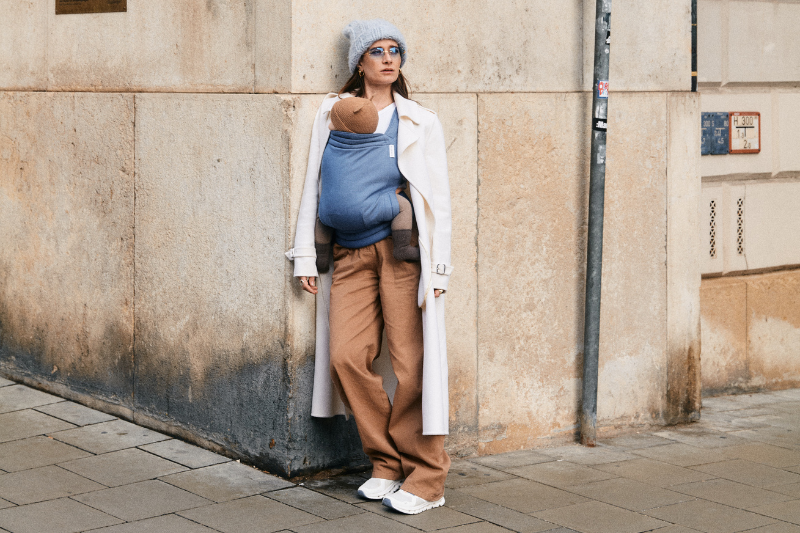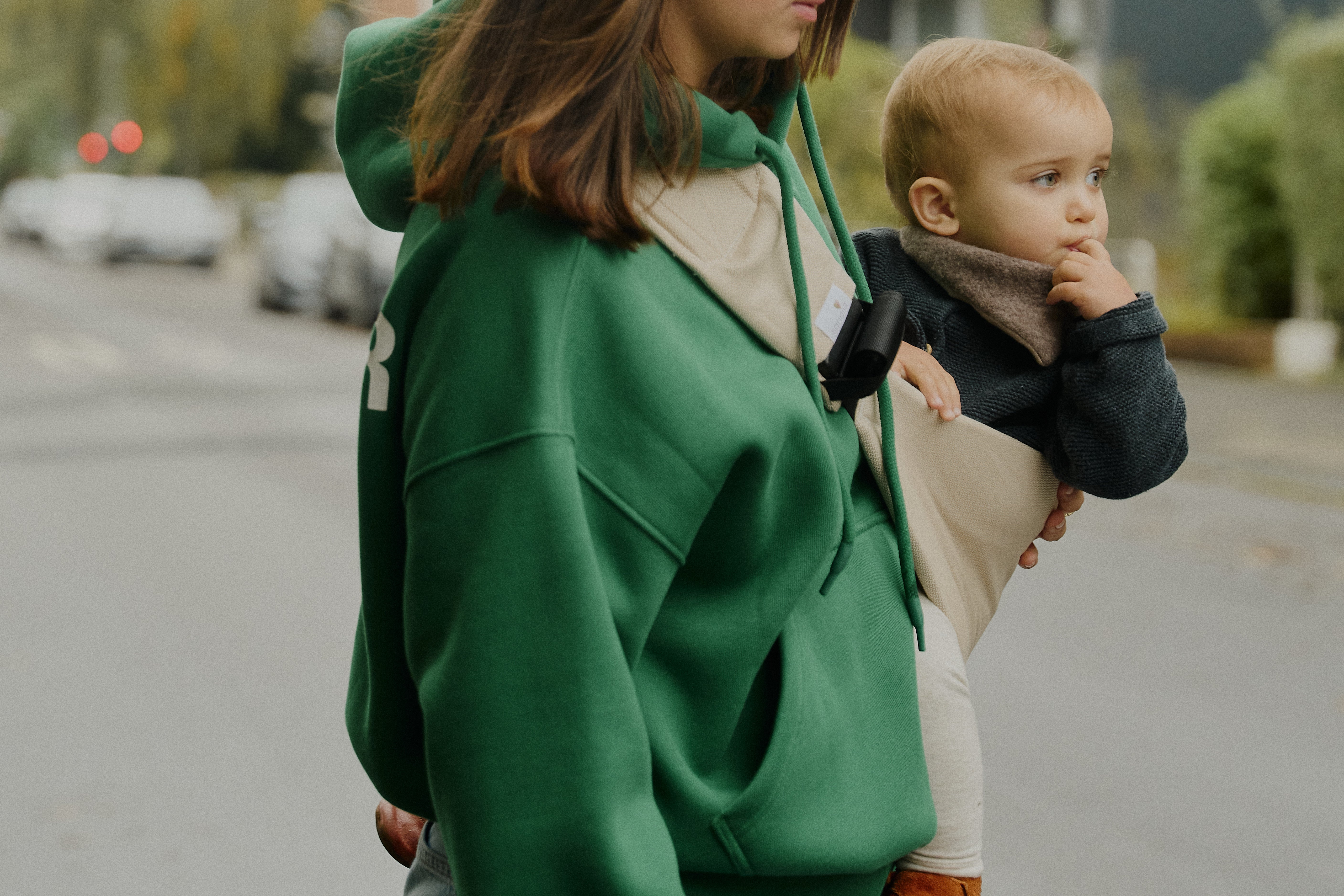
Babywearing during pregnancy – Is it possible? Tips and recommendations
Closeness, even with a baby bump: Babywearing during pregnancy
Many parents love to carry their children – and often, with a subsequent pregnancy, the question arises: Can I continue carrying my baby if I am pregnant again?
The good news: Yes, babywearing during pregnancy is still possible in many cases – provided you feel comfortable and your pregnancy is progressing without complications. Especially with a second (or third) child, babywearing is often an integral part of family life – making it all the more important to consciously consider the topic.
In this article you will learn:
-
When is babywearing safe during pregnancy?
-
Which carrying positions are gentle on the stomach
-
Which baby carriers are particularly suitable
-
And what you should pay attention to in each stage of pregnancy
Is babywearing allowed during pregnancy?
Generally speaking, there is no medical reason against wearing a bra during pregnancy , as long as you:
-
You have no complications (e.g., bleeding, premature labor, placental problems)
-
You feel physically fit
-
Don't overload your pelvic floor
-
And that wearing it remains comfortable for you.
The important thing is: listen to your body. If you experience back pain, dizziness, or pressure in your lower abdomen, you should pause carrying the baby or adjust how you carry it.
Tip: Discuss this topic with your midwife or gynecologist during your prenatal appointment – especially if you are unsure.
Carrying positions during pregnancy
🤰 From the 1st trimester (until about week 12)
In early pregnancy, the baby is still small in the womb, and the uterus is low in the pelvis. During this phase, you can still carry your child in front as usual , provided you feel well. Most women don't experience any physical limitations yet.
🤰 From the 2nd trimester
As your belly grows and your body posture changes , carrying your baby in front becomes increasingly uncomfortable . Now it's worth switching to side or back carries .
-
The hip carry position relieves pressure on the abdomen and is ideal for shorter carrying times.
-
Carrying the baby on your back is easier on your back and takes the pressure off your stomach – especially during longer periods of carrying.
🤰 In the 3rd trimester
Your belly has probably grown considerably by now. Back carrying is now almost the only recommended option – provided you feel confident putting it on (with help if necessary). Make sure the carrier provides good support and that you don't feel any additional tension in your abdominal area.
Which baby carriers are suitable during pregnancy?
Not every baby carrier is equally suitable during pregnancy. The crucial factors are that it doesn't constrict your baby bump , provides good back support , and can be individually adjusted .
🟢 Baby carrier (woven)
A classic among babywearing parents – and also very versatile during pregnancy. You can tie the wrap in such a way that it doesn't put any strain on your belly. Especially ideal for side carries or back carries .
💡 Tip : The front wrap cross carry is often too focused on the belly during pregnancy. Alternatives like the back carry or simple hip carries work better.
🟢 Halfbuckle carrier
It combines buckles and tie straps – an advantage during pregnancy, as you can adjust the shoulder straps individually, while the waist belt provides stability. Make sure the waist belt sits below your belly, on your pelvis – not in the middle of your baby bump.
What you should consider when babywearing during pregnancy
✅ Don't wear them for too long at a time.
Even if you're used to carrying your baby, you'll need more frequent breaks when you have a baby bump. Pay attention to your body's signals.
✅ Always wear close to your body
The closer your child sits to your center of gravity, the better the weight is distributed – this relieves the back and protects the stomach.
✅ Apply preferably while seated or with assistance
Especially with back carries, putting the baby on while standing with a baby bump can sometimes be difficult. Ask someone for help or use a stool or the bed.
✅ Avoid baby carriers with a firm, tight hip belt
These can be uncomfortable and are not ideal for pregnant women.
✅ Keep moving
Regular moderate exercise – such as walking with a baby carrier – promotes your well-being and keeps your back mobile.
Psychological aspects: Closeness, security & sibling bonding
Especially with the second or third child, babywearing is an important part of nurturing the bond. It helps to show the older child: "I'm here for you – even with a baby in my belly."
For many toddlers, this is an important constant during a time of change. Physical closeness helps with the transition to sibling roles, reduces jealousy, and provides security.
Furthermore, carrying a baby during pregnancy is often practically the only option – e.g., when the older child is tired, falls asleep while shopping, or seeks closeness.
When you should no longer wear it
Even if you love babywearing: There are situations in which you should take a break:
-
You have premature contractions , a shortened cervix , or pre-existing medical conditions.
-
You feel insecure or unstable while wearing it.
-
Your circulatory system isn't cooperating.
-
Your gynecologist or midwife explicitly advises against it.
Then the following applies: Closeness is possible even without a baby carrier – through cuddling, reading aloud, sitting together or quiet play moments.
Conclusion: Babywearing during pregnancy – yes, but consciously
Babywearing during pregnancy is possible – with the right carrying technique, suitable carriers, and a good dose of intuition. Listen to your body, take breaks, and use carriers that don't constrict your baby bump.
Especially during this time, baby carriers like the Onbuhimo or flexible half-buckle carriers are invaluable. They provide your older child with closeness and security – and give you freedom of movement and make everyday life easier.


